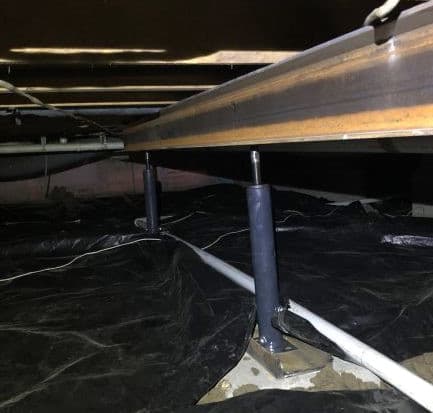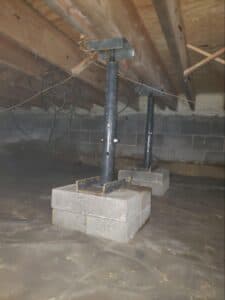Why Is Replacing the Main Beam Necessary? Details About Our Repair Methods

If your floor is sagging or sloping towards the center of your home, this means your main beam is struggling to support your house. There are two possible explanations for this. The best case scenario is that the support columns under the beam need repairing or supplementing. This is a relatively quick and lower cost repair.
But if the beam itself is damaged, rotting by moisture, decayed with mold, or besieged by termites? You will need to replace the main beam entirely. This is more expensive repair, and homeowners often question if it’s truly necessary.
Acculevel is a family-owned and operated company that specializes in foundation repair and waterproofing. We have been helping homeowners protect their greatest investments since our start in 1996. Since that time, we’ve restored strength and stability to more than 35,000 homes throughout Indiana and the surrounding areas.
In this blog, we’re going to explain why we believe replacing a damaged main beam is the best option for you and your home.
What if Your Main Beam Isn’t the Problem?
When you notice your home sagging towards the center of your home, it’s time to inspect the main beam of your house. You can’t just assume the beam is defective without taking a good close look at it and the other wooden components of your flooring structure.
Building code requirements have varied a lot over the years, and the weight of our possessions has changed, too. Granite countertops, pool tables, even extra large appliances can strain a flooring structure that wasn’t designed to support these modern furnishings.
Support Columns May Be The Issue
There’s always the possibility that the beam is in good shape, but it’s not being properly supported. A builder should place support columns every few feet, to help support the main beam. If these columns are placed too far apart, adding some steel floor jacks can resolve the issue. Likewise, if the columns themselves are damaged, replacing them with steel jacks could be the needed answer.

This photo was taken by an Acculevel crew member, after replacing damaged support columns with steel floor jacks. In this instance, the main beam was in excellent condition.
Why Not Add Beams on Either Side of the Sagging Beam?
If the beam is damaged, we will recommend that you replace it. As we admitted earlier, beam replacement is expensive. It’s a labor intensive repair, often performed in a crawl space that limits how quickly a crew can work. Some contractors will suggest a cheaper option, which is to install supplemental beams on either side of the sagging main beam.
This is not something Acculevel will recommend, and it’s not because we want to charge you as much as possible. It’s because we know that beam replacement is the best solution, and it will last for a much longer period of time.
In most cases, builders install the main beam directly under a load-bearing wall of your home. And if this is how your home is designed? Supplemental beams won’t lift your floor or add any true support to the main beam. It might help for a little while, but it’s a short-term solution at best.
Eventually, the main beam will start to break down from the strain. At that point, you’ll end up replacing it. This means you’ll have paid for two repairs, instead of just one.

This photo was also taken by an Acculevel crew member after making repairs. This home had a damaged main beam and failing support columns. We replaced both, using a steel I-beam and adjustable floor jacks.
Another difference you may notice is the building material Acculevel uses.
We install steel I-beams instead of wooden ones.
Why Not Add a Beam Below the Existing Beam?
Another possible option that some contractors may offer is supplementing the beam itself. They sometimes add another beam to the existing beam. This requires modifying or lowering the supports to accommodate your now-much taller main beam.
Again, this may temporarily solve the problem. But what they’ve actually done is increase the stress and pressure on an already-straining beam. Now that main beam is trapped between the weight of your home and a new beam. Imagine you’ve put a board in a steel vice, and you just keep tightening it. What happens to the board? Your beam isn’t really any different. Over time, that wooden beam can compress (flatten) or twist from the strain.
And what happens then? You have to have the main beam and the secondary one removed, and then a new one installed in its place. Plus, all of the support columns will have to be rebuilt or adjusted back to their original height. You’ve paid for both a short-term fix and a long-term replacement repair. Like the earlier option, this has bought you some time, but has cost you more money in the long run.
Have More Questions about Sagging Floor Repairs?
We have developed a detailed homeowner’s guide to crawl space repairs, and this resource is available free of charge. Please bookmark it, share it, and come back to it any time you notice something amiss with your home.
Acculevel Provides Whole-Home Solutions
Our goal is to recommend the best solution to whatever issues you have encountered with your home. We are focused on your best interests, and what repairs will best serve your needs. We understand that the cheapest solution isn’t always the best one; sometimes, it’s only going to postpone what’s genuinely necessary.
If you live in our service area, give us a call at 866-669-3349. (Not sure? Check via our interactive service map!) We’ll schedule an appointment for you with one of our expert project advisors, who will discuss your concerns and plans for your home.
Once the project advisor is familiar with your goals and the history of the house, they’ll conduct a thorough review of your home. You’ll then meet again to review the results of the inspection, and work together to formulate the best plan to repair your home and protect it for the future.
Do you work third shift? Run a home business and need to avoid interruptions? Prefer to have conversations in writing, to keep all the details organized? We understand! Fill out our online form and tell us you’d rather communicate by text or email, and we’ll reach out to you accordingly.
If you don’t live in Indiana or the surrounding areas, please make sure any contractor you work with is properly insured and accredited by the Better Business Bureau. Please use our homeowner’s guide; we genuinely mean for it to be used by any homeowner who needs the information! Also, we have an article that provides the questions you should ask a contractor, which includes a free downloadable questionnaire.

